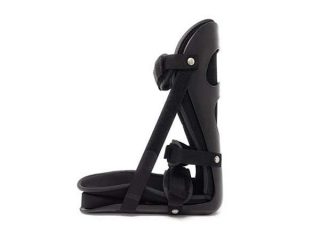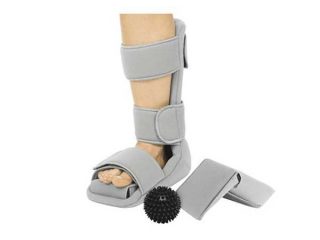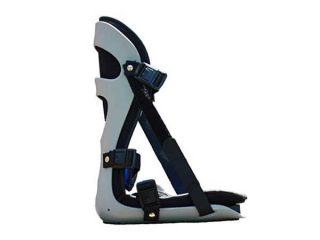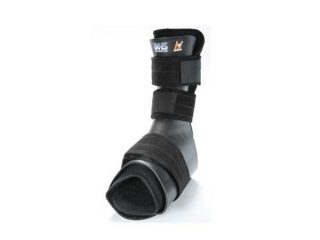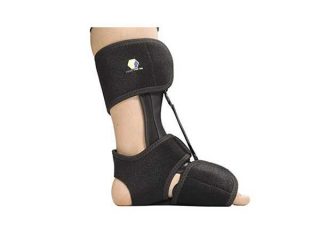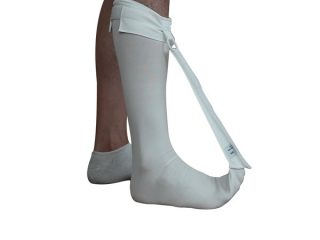It’s the reason you dread getting out of bed in the morning. That first excruciating step out of bed… that feeling of a hot spike being driven through your heel. But there is at least one way, supported by documented studies, that can help reverse your heel pain. Using a night splint for plantar fasciitis, in combination with stretching, has provided relief for many while also being backed by science.
Of course, there is no one treatment to guarantee an end to your morning foot pain. However, many people with plantar fasciitis have testified to its benefits in minimizing (or completely resolving) that excruciating morning pain. The concept of a foot splint is supported – keeping your fascia ligament stretched while you sleep, in order to avoid that tightness as you first step out of bed. And while wearing a boot to sleep may seem a bit inconvenient, it has a track record of success for those stubborn cases of heel pain.
The good news is that there are a number of people just like you who have found that by wearing a foot boot at night, they can get up in the mornings and notice less pain over the following weeks.
That’s the bottom line. Of course, you need to stick with the protocol.
Benefits Of Wearing A Plantar Fasciitis Night Splint
- Maintains the foot in a 90-degree dorsiflexed position. This stretches the fascia and in many cases relieves that menacing “first step” in the AM.
- Sustains a stretch to the Achilles tendon and calf muscles, which have been thought to play a role in plantar fasciitis.
- One time purchase. No need to worry about replacing it every 6 months like you would have to do with shoes, insoles, etc.
The drawback of wearing a night splint, of course, is the cumbersome process for some people. It has been compared by some to wearing a snow boot to bed.
However, those willing to stick out the protocol have the greatest potential to see definitive improvements in their heel pain.
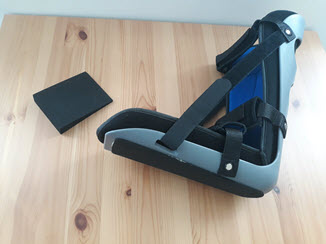
90 Degree Stretch 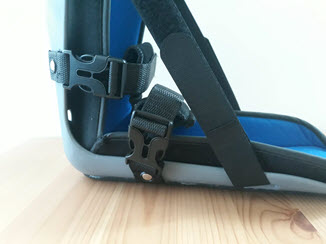
Secure Connectors
Different Types Of Night Splints
There are two primary types of splints for dealing with plantar fasciitis – the Dorsal and the Posterior boot. The visible difference is that the rigid support structure on each type is on the opposite side of the foot.
The Dorsal splint has a hard plastic support that rides along the shin and top of the foot to keep it firmly at a 90-degree angle, while leaving the heel and arch free to breathe.
The Posterior (Boot) splint looks just as it sounds. The spine of the brace is on the back of the leg and calf, and runs under the foot. It is generally a larger brace than the dorsal style.
There does not seem to be a consensus on which type of brace is better, so you’ll have to determine for yourself which is more likely to be beneficial.
Common Complaints With The DORSAL Brace
1. Design characteristics may cause the foot to slip out of place, not always holding the stretch.
2. Added pressure by the toes sometimes causes them to tingle and/or fall asleep.
3 . Larger straps may cause sweating for some users.
Common Complaints With The BOOT Brace
1. May be large and uncomfortable for first time users.
2. Toes can go numb if not used to the constant foot flex.
3. Mobility will be limited if you need to get up and move around the house.
Studies And Data: Night Splint Effective When Used With…
Most statistical support for the treatment of plantar fasciitis seems to indicate that the use of a combined set of conservative treatments provides the best outcome in treating heel pain.
In a randomized study to evaluate the efficacy of a tension night splint, 15 patients assigned to a night splint treatment protocol were cured or found significant improvement to pain, plantar fasciitis tenderness and/or ankle range of motion in an average of 12.5 weeks. Upon conclusion of the study, it was determined that a tension night splint, in conjunction with Ibuprofen, stretching and heel cushions, proved effective in treating plantar fasciitis. Talk to your physician to see what’s right for you.
…15 patients assigned to a Night Splint treatment protocol were cured or found significant improvement to pain.
ncbi.nlm.nih.gov
In another study performed by the University of Pittsburgh, three control groups of 30 persons each were set up to determine the efficacy of using either 1) only Night Splints, 2) using only Arch Supports, or 3) the use of both in treating plantar fasciitis. It was concluded that the use of both, a night splint and arch supports, might be a more effective treatment than the use of either individually as a sole treatment option.
Most studies performed over the last 15 years have found similar favorable reviews of a night splint as a treatment option (when used in conjunction with other orthotic support).
How We Rate The Night Splints
Best Plantar Fasciitis Night Splint
(Click Image to Enlarge – Link for Amazon Reviews)
1. Mars Wellness Night Splint
The Mars Wellness Night Splint is designed to provide relief from the morning pains associated with plantar fasciitis. This night boot is engineered with dual tension straps, a foot wedge and 3 additional padded straps for immobilization. It functions to keep your foot stretched all night in a dorsiflexed position. We’ve rated this as the best night splint for plantar fasciitis based on its favorability score.
- Seller responds to poor reviews for resolution
- Affordable pricing
- Works for many to get morning relief
- Comes in more sizes than others
- Removable washable fabric
- Couple sizing issues (seller recommends this is not for shoe size less than 6.5)
- Some complaints of toes getting numb from sustained stretch
- Attaching the clips may be cumbersome as they adjust in only one direction
- May not work for large calves
- Difficult to sleep in
2. Vive Night Splint
The Vive night brace is your typical plantar fasciitis boot, designed to reduce pain and inflammation first thing in the morning. It comes with a couple foot wedges for better positioning and a foot massaging ball as additional bonuses. This night splint is designed with 3 velcro straps and a soft padding that covers the entire shell, perhaps making it the most comfortable splint on the market.
- 4 sizes available
- Comes with foot massage ball and wedge
- Soft padding against skin
- Works for morning heel pain relief
- Seller responds to negative reviews (but not all) and offers solution
- Removable washable padding
- Strap over foot can rub into skin for some
- Multiple complaints of velcro strap coming off easily or not lasting long
- Difficult to sleep in
- Some complaints of being too loose and foot slippage out of flexed position
3. Alpha Medical Night Splint
The Alpha Medical Night Splint for plantar fasciitis promises simple engineering that delivers results. Their lightweight profile, padded straps and foot breathability all provide convenience to an otherwise cumbersome sleep device. Keeping your fascia stretched and feeling relaxed first thing in the morning, however, is why this boot is just as promising as the Mars Wellness or Vive night splints.
- 3 sizes available
- Affordable pricing
- Removable washable pad
- Works for many to get that morning relief
- Hard to sleep in
- May be uncomfortable for wide calves
- Strap across the foot may cause comfort issues
- Toe may be susceptible to numbing
- Attachment clips are cumbersome as they are only on one side of splint
- Some complaints of foot not securely fitted in
4. Cramer Dorsal Night Splint
Unlike boot braces, Cramer produces the less-bulky Dorsal Brace for plantar fasciitis sufferers. Breathable, soft padding enhances comfort while also holding the foot in a 90-degree angle while you sleep or lounge around the house. An anti-slip foot pad enables you to walk around the house easier than in a posterior night splint.
- Easy to adjust
- Gives nice stretch
- Less bulky than larger boot
- Velcro seems to last longer than others
- Straps may slip and cause foot to fall out of position
- May not be good for wide calves
- Customer support not active in responding to negative reviews
- No return policy
5. Mars Wellness Dorsal Night Splint
The Mars Comfort Dorsal is fairly similar to the Cramer splint, with the exception of a small difference in how the straps are designed. This Dorsal Brace also comes in a low-profile construction, with 3 padded straps to secure the foot tightly into position. This night splint does a good job holding your foot in a neutral position while you sleep, while not being as bulky as others.
- Easy to use – Less bulky than larger boots
- Padded for comfort
- Works for many as intended
- Seller responds to some negative feedback and offers solutions
- Only 2 sizes available
- Not for wide calves as per seller
- Velcro may wear out a bit prematurely
- Design is a bit different and may bother some
6. The Strassburg Sock
We’ve already reviewed the Strassburg Sock in our plantar fasciitis socks review, but it would be more appropriately listed here. While not having the hard plastic spine of a traditional night splint, this sock’s key feature is as a knee-high sock with material from the toe attaching directly to the knee area. This is how they are able to maintain a stretch of the plantar fascia and give results similar to those from the night splints. It is much less cumbersome in general, but has mixed reviews. When all else fails, we’ve listed this as another option for you to explore.
- Seems to get some results if you find the right fit
- Easy to wash and has low profile
- May be more comfortable than the boot
- No return policy
- Seems gimmicky to some
- May pull toes more than actually flex the fascia
- No response to negative reviews from seller
- May be best for taller people
- Cuts off circulation for some
- Only comes with one sock for the listed price
Conclusion
Hopefully you have seen enough information that you can determine if you might need a night splint for your plantar fasciitis pain. These are some of the best options according to people just like you and have been documented to work for those that stick to the treatment protocol, while combining it with the use of an orthotic insert during daytime weight-bearing activities.
As you have seen, there is plenty of support (group studies and personal testimonies) that support using plantar fasciitis night splints for reducing heel pain, and/or getting rid of it altogether. It is one of the protocols that people do have trouble following, but if you feel that it could benefit you there are certainly testimonials that validate its use.
Make sure to consult a physician before starting any treatment options. And if you’d still like to learn more, you can check out our infographic that explains exactly what is plantar fasciitis, the symptoms, treatment protocols that work and much more.

